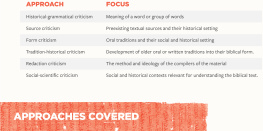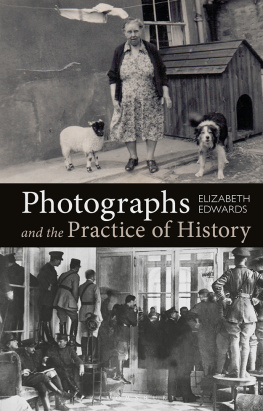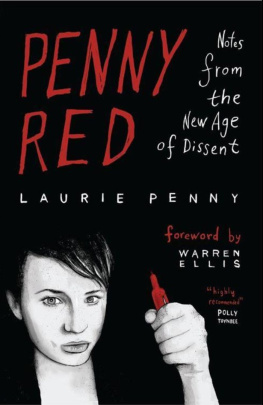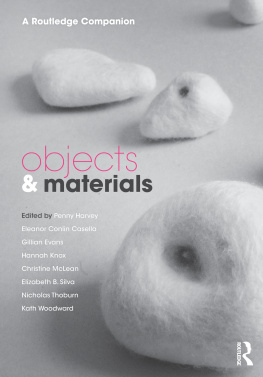Using Photographs in Social and Historical Research
SAGE has been part of the global academic community since 1965, supporting high quality research and learning that transforms society and our understanding of individuals, groups and cultures. SAGE is the independent, innovative, natural home for authors, editors and societies who share our commitment and passion for the social sciences.
Find out more at: www.sagepublications.com
Using Photographs in Social and Historical Research
Penny Tinkler
SAGE Publications Ltd
1 Olivers Yard
55 City Road
London EC1Y 1SP
SAGE Publications Inc.
2455 Teller Road
Thousand Oaks, California 91320
SAGE Publications India Pvt Ltd
B 1/I 1 Mohan Cooperative Industrial Area
Mathura Road
New Delhi 110 044
SAGE Publications Asia-Pacific Pte Ltd
3 Church Street
#10-04 Samsung Hub
Singapore 049483
Editor: Jai Seaman
Assistant editor: Anna Horvai
Production editor: Vanessa Harwood
Copyeditor: David Hemsley
Proofreader: Derek Markham
Marketing manager: Ben Griffin-Sherwood
Cover design:
Typeset by: C&M Digitals (P) Ltd, Chennai, India
Printed in India at Replika Press Pvt Ltd
Penny Tinkler 2013
First published 2013
Apart from any fair dealing for the purposes of research or private study, or criticism or review, as permitted under the Copyright, Designs and Patents Act, 1988, this publication may be reproduced, stored or transmitted in any form, or by any means, only with the prior permission in writing of the publishers, or in the case of reprographic reproduction, in accordance with the terms of licences issued by the Copyright Licensing Agency. Enquiries concerning reproduction outside those terms should be sent to the publishers.
Library of Congress Control Number: 2012941368
British Library Cataloguing in Publication data
A catalogue record for this book is available from the British Library
ISBN 978-0-85702-036-9
ISBN 978-0-85702-037-6 (pbk)
To Carolyn
Contents
About the Author
Penny Tinkler is a Senior Lecturer in Sociology at the University of Manchester. She has written several articles and chapters on photographic methods and practices. She has also written extensively on the history of girlhood, including Constructing Girlhood: Popular Magazines for Girls Growing up in England, 19201950 (Taylor & Francis 1995), and on the feminization of smoking, including Smoke Signals: Women, Smoking and Visual Culture in Britain 18801980 (Berg 2006).
Acknowledgements
I am extremely grateful to all those who have generously contributed case studies and interviews and engaged in extended correspondence with me about their research: Stephen Brooke, Richard Chalfen, Kathryn Davies, Elizabeth Edwards, Patrizia Di Bello, Janet Fink, Jane Hamlett, Jennifer Mason, Darren Newbury, Annebella Pollen, James Ryan, Helene Snee and Toni Weller. I would also like to thank the many people who have responded to questions and provided photos, feedback and technical support, often at very short notice, in particular: Shirley Baker, Hannah Barker, Julia Bennett, na Bhroimil, Hazel Burke, Anna Carden-Coyne, Teresa Doherty, Alexander Freund, Karen Harvey, Douglas Harper, Alice Jesmont, Annette Kuhn, Andrew Loxley, Wendy Luttrell, Phil Mizen, Lorie Novak, Alistair Thomson, Valerie Walkerdine and Sophie Woodward. I am also grateful to the archivists and librarians who have tracked down images and arranged permissions. For support and advice, thanks to my colleagues in Sociology at the University of Manchester and to the editorial and production teams at Sage. Thanks also to my friends for keeping me sane.
Special thanks go to my partner, Carolyn Jackson, to whom this book is dedicated. This book would not have been possible without her enduring support. I am immensely grateful to Carolyn for her constructive feedback and insightful comments on all my chapters, and for her valiant efforts to motivate and sustain me throughout the course of this project.
List of Figures
About this Book
Since the 1850s photographs have become increasingly integral to how we live our lives. They shape what we know, feel and remember about ourselves and the wider world in the present and past, and they play a part in how we work, learn, consume, relax, communicate and relate to one another. Photographs are also of growing importance in research, and they have the potential to become an important element of social inquiry; this is because there is a vast and growing stock of photographs relating to social life past and present, but also because we can generate our own photos on many topics we research.
Confronted by this exciting resource, the question is how to use photos productively in social and historical research. This book will guide researchers and students in working this out. Focusing exclusively on photographs, this book investigates how photos can be used in research and the conceptual and theoretical issues that underpin this practice. It is interdisciplinary in perspective, drawing on developments and examples from history and the social sciences. It approaches photographs as images that can be interpreted as texts and evaluated as evidence of the social and material world they depict, but it also engages with photographs as three-dimensional objects. Discussing and evaluating different research strategies the book offers new critical insights on how to think about and use photos to address questions about social and cultural life. Rather than offer readers a menu of established methods, the book is organised around what researchers do with photographs and engages with established and emergent methods as well as generic research techniques. It covers methods for working with images, for taking photos and listening to people talk about them. It also examines how to research photographic practices, that is how and why people and organisations make and use photographs and what these practices mean. There is an understandable tendency in methods literature to offer sanitised versions of how research is undertaken, even though research is often messy. This messiness is not a failing of individual researchers or research designs but an often unavoidable part of doing research on complex phenomena. Talking to researchers about their practices and experiences and integrating these interviews into this book, I offer glimpses of the messy, pleasurable, challenging and productive dimensions of using photos in historical and social research.
This book foregrounds using photos to research the past, memory, biography and change; this is because these applications have so far received very little attention in methods texts. It is also because these topics are important to historians and researchers of contemporary life; the present is never static and multiple times co-exist and shape it. The book demonstrates how photos can be used to engage with these temporalities, including change and continuity, process, biography and autobiography, also the personal and collective memories1 that shape identities, historical consciousness and perceptions of the relationship between past and present.














